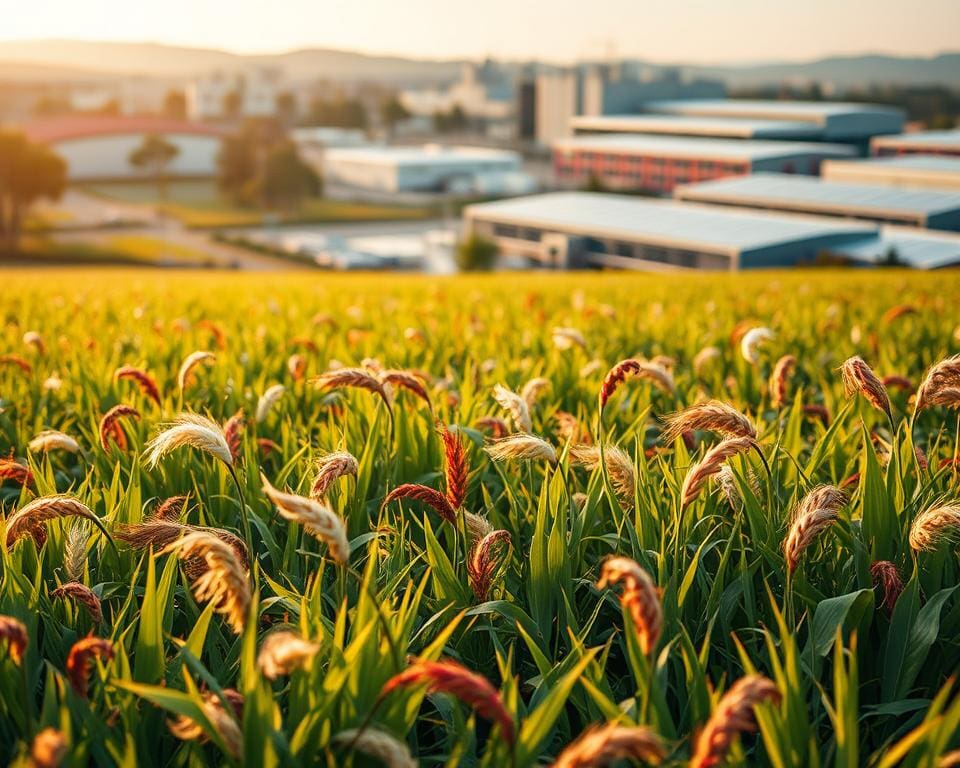The fashion industry is undergoing a remarkable transformation as sustainable fabrics take centre stage. Increasingly, consumers are calling for eco-friendly textiles and ethical clothing that not only reflect personal style but also contribute positively to the environment. Research shows that textiles account for a significant portion of waste in landfills, which underscores the urgency of shifting towards a more sustainable fashion industry.
Leading brands such as Stella McCartney and Patagonia are pioneering this movement, demonstrating how sustainable fabrics can embody both style and responsibility. This shift is not merely a trend; it represents a necessary evolution towards a greener future, where sustainable practices are at the heart of fashion design and production.
The Rise of Sustainable Fabrics
The fashion industry is experiencing a significant transformation with the rise of sustainable fabrics. Understanding what constitutes sustainable fabrics involves exploring their origins and how they differ from traditional textiles. These materials are derived from renewable resources, often employing methods that minimise environmental impact. Sustainable textile definitions highlight the importance of using non-toxic and recyclable materials, which are essential in creating a more sustainable future for fashion.
Understanding Sustainable Fabrics
Sustainable fabrics are crafted from organic materials such as hemp, bamboo, and organic cotton, known for their lower environmental footprints. They are produced through practices that conserve water and energy while avoiding harmful chemicals. The innovative textiles emerging in the market contribute to the rise of sustainable fabrics, as they incorporate advanced technologies for eco-efficient production processes.
Benefits of Sustainable Fabrics
The benefits of eco-friendly fabrics extend beyond environmental advantages. Choosing sustainable fabrics can significantly reduce carbon footprints and water consumption. For instance, studies reveal that organic cotton uses 91% less water compared to conventional cotton, emphasising its role in promoting sustainability. Additionally, these fabrics support ethical labour practices, ensuring fair treatment and wages for those involved in the production process.

Sustainable Fabrics Changing the Industry
The fashion landscape is undergoing a profound transformation, driven by the growing impact of sustainable fabrics. Designers and consumers alike are embracing this shift toward responsible consumption. The focus has moved from fleeting trends to timeless pieces that prioritise quality and environmental impact. As a result, changing fashion norms are becoming evident, highlighting the importance of sustainability in the design process.
How They Are Impacting Fashion Norms
Fashion houses are redefining their values, incorporating sustainable practices into their core operations. This shift encourages brands to prioritise ethical manufacturing and eco-friendly materials. By adopting sustainable fabrics, they enhance their brand image while appealing to a conscious consumer base. With an emphasis on transparency, many brands are now committed to showcasing their production processes, making sustainability a prominent feature of their identity.
Case Studies of Brand Transformations
Remarkable case studies in sustainable fashion demonstrate how leading brands are successfully adapting. H&M has launched collections that include garments crafted from recycled materials, marking a significant step toward eco-consciousness. Nike, similarly, has embraced sustainability in its initiatives, creating footwear that utilises innovative, sustainable resources. One standout is Reformation, a brand celebrated for its transparent approach to sourcing and production. This commitment not only resonates with customers but inspires an industry-wide change towards responsible practices.
Types of Sustainable Fabrics
The fashion industry is undergoing a substantial transformation, with an increasing focus on sustainability. Various types of sustainable fabrics are emerging, each offering unique benefits and environmental advantages. Understanding these materials is key to making informed choices in our clothing purchases.
Organic Cotton and Its Benefits
Organic cotton stands out as one of the most popular types of sustainable fabrics. Grown without synthetic pesticides or fertilisers, this material not only supports biodiversity but also enhances soil health. The production process prioritises environmental sustainability, making it a favourable option for eco-conscious consumers.
Bamboo: A Sustainable Alternative
Bamboo fabric is another excellent choice for those seeking sustainable clothing. This remarkable plant boasts rapid growth and regenerative properties. It can be transformed into soft, breathable, and biodegradable textiles, offering comfort while reducing environmental impact. The versatility and natural qualities of bamboo make it an attractive option in the realm of sustainable fabrics.
Recycled Polyester and Its Uses
Recycled polyester is revolutionising the way we think about waste in the fashion industry. Derived from used plastic bottles, this material demonstrates how discarded items can be repurposed into high-performance textiles. By utilising recycled polyester, brands can significantly reduce their reliance on virgin resources while diverting waste from landfills, contributing to a more sustainable future.
The Role of Innovation in Sustainable Fabrics
Innovation in sustainable textiles is reshaping the fashion industry, introducing fresh ideas and methods that redefine fabric production. Technological advancements play a critical role in minimising waste and enhancing efficiency within manufacturing processes. Exhibiting creativity, these innovations significantly contribute to a more sustainable future for textiles.
Technological Advancements
Modern production methods, including 3D printing and digital fabric printing, exemplify the remarkable technological advancements driving innovation in sustainable textiles. These techniques allow designers to create patterns digitally, reducing excess material and waste while enabling unparalleled precision. Brands are leveraging automation and artificial intelligence to optimise resource use, resulting in a more eco-friendly approach to fabric creation.
Biodegradable Materials and their Future
The focus on biodegradable materials exemplifies a transformative shift towards sustainable practices. Materials derived from sources like mycelium and seaweed demonstrate how nature can inspire innovation. These biodegradable options not only decompose but also enrich the soil, marking an essential step towards a circular fashion model. As awareness grows, the future of sustainable textiles appears promising, with a commitment to developing materials that benefit both consumers and the planet.
Challenges Facing Sustainable Fabrics
The journey towards sustainable fabrics is fraught with various challenges that hinder widespread adoption. Among these, cost vs sustainability stands out as a pivotal concern. Producing sustainable materials often involves extensive resources and advanced technologies, leading to higher production costs compared to conventional fabrics. As awareness grows and demand increases, it is anticipated that economies of scale will gradually ease these financial burdens, but this evolution requires time and commitment from both manufacturers and consumers.
Cost vs. Sustainability
Many consumers are willing to invest in sustainable fashion, yet the price tags on these garments can deter purchases. The challenges of sustainable fabrics often manifest in pricing models that reflect the costs incurred during the production process. While initial expenses may be higher, the long-term benefits of investing in eco-friendly materials include reduced environmental impact and ethical manufacturing practices.
Supply Chain Issues
The complexities of the supply chain in sustainable fashion further complicate the landscape. Sourcing sustainable materials involves navigating a network of suppliers who adhere to ethical standards. Ensuring transparency and accountability throughout this process is essential but challenging. These supply chain issues can affect the availability of sustainable fabrics, ultimately influencing their prices in the marketplace.
The Future of Sustainable Fashion
The landscape of sustainable fashion continues to evolve, largely driven by changing consumer behaviour and a newfound awareness around sustainability. As consumers increasingly seek ethically produced apparel, the demand for transparency in sourcing and manufacturing processes gains momentum. Individuals are evidently more inclined to support brands that align with their values, demonstrating a readiness to invest in sustainable clothing. This shift ushers in an optimistic future for the sustainable fashion industry.
Consumer Behaviour and Demand
Today’s consumers exhibit a heightened sense of responsibility regarding their purchasing choices. Many favour brands that prioritise ethical practices and environmental preservation. Such consumer behaviour underscores a significant transformation in the marketplace, where sustainability takes precedence over fast fashion trends. This shift in mindset leads to an increased interest in sustainable materials and practices, suggesting that future purchases will focus on longevity and quality rather than short-lived trends.
Predicted Trends in Sustainable Fabrics
The future of sustainable fashion appears bright, with several intriguing trends in sustainable fabrics expected to emerge. The rise of rental services signifies a shift away from ownership, allowing consumers to access high-quality garments without contributing to waste. The second-hand clothing market flourishes alongside this, offering unique finds and ensuring that resources are used more efficiently. Furthermore, innovative technologies such as bio-fabrication are set to revolutionise the production of fabrics, reducing environmental impacts while meeting the burgeoning demand for sustainability.
Becoming a Responsible Consumer
As the fashion industry shifts towards sustainable practices, the role of consumers becomes increasingly pivotal. Adopting responsible consumerism is not merely an option; it’s an essential step towards a greener planet. By making informed choices, individuals can significantly influence the market, supporting brands that prioritise sustainable purchasing and ethical practices.
Choosing sustainable fibres often means looking beyond conventional retail options. Opting for second-hand clothing instead of fast fashion not only helps reduce waste but also promotes a culture of reusability. With the rise of platforms such as Depop and ThredUp, environmental responsibility in fashion can be effortlessly woven into daily life, enhancing ethical fashion choices while being stylish.
Beyond personal choices, prioritising quality over quantity can also reshape consumer habits. Investing in high-quality, sustainable pieces ensures longevity, making each purchase more meaningful. When individuals commit to responsible consumption, they collectively foster a demand for sustainable practices, driving the fashion industry to a greener, more ethical future.









